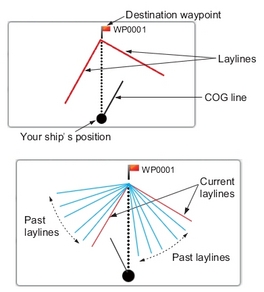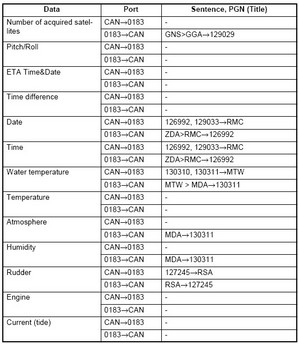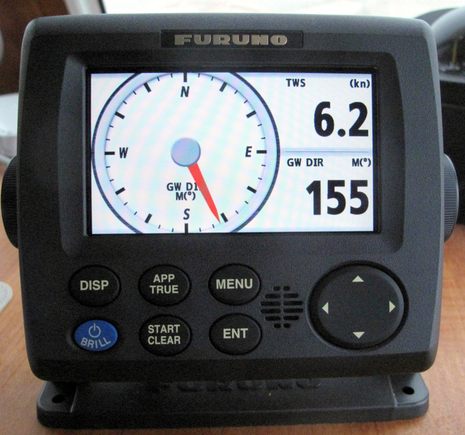Furuno RD-33 & GP-33, looking very good
Thanks to Panbo readers “arisatx” and “Recovering Racer”, commenting on one of the FI-50 instrument entries, we’ve learned that Furuno is introducing an RD-33 data display with a bright, high res 4.3-inch color display and powerful abilities not only at displaying NMEA 2000 and 0183 data but also at bridging either type between sensors and other displays. There’s going to be a somewhat similar GP-33 GPS, too, and the details of both look very good indeed…
For starters, consider the RD-33 in context with the other NMEA 2000 all-in-one color data displays. This little comparative table I put together is missing some values, and some categories, but the new Furuno display seem to shine, especially given that one U.K. site has the RD-33
at $460 (and another has the GP-33
at $610). I can’t find any brightness stats for the other displays, but I’ve seen them in action, and am hopeful that Furuno’s 700 nits is near Garmin GMI 10 readability, with less power drain.
 Now, if you go to the
Now, if you go to the
FurunoUSA site and search on “RD33” or “RD-33” (Furuno seems loose about the hyphens in its model names), you’ll find a download link to a thorough manual in PFD
format. Just remember that in Furuno speak “CAN bus” equals “NMEA 2000,” as we’ve discussed at length. The RD-33 has the same dual CANbus/N2K ports — one male and one female — that enables daisy chaining but precludes NMEA certification, and I’ll have more to say about the dangers of daisy chaining soon. But no one has to use the second N2K port, and, aside from the nomenclature oddness, the RD-33 manual is exceptionally clear about the device’s NMEA compatibility, as discussed below.
I’m a long time fan of Furuno’s original monochrome RD-30 (which I once described as a friendly robotic assistant), but in retrospect its screens are pretty utilitarian. Not so the RD-33. As you can see somewhat in the top photo — and more of in the brochure and manual — Furuno clearly tried to match or even beat the attractive data displays the competitors designed. One graphic that got my attention, and may be unique, is this layline representation below, which can even show prior laylines to help a sailor track wind shift trends. I also noticed that the RD-33 can display current set and drift at three different water levels, which must be valuable to the commercial fishermen equipped to measure such values. I believe that RD-33 is the only data display that understands both NMEA 0183 and 2000 data and can do some translations both ways. (Garmin’s GMI 10 can read both, but does no bridging, while Raymarine’s ST70 series can do some translating from SeaTalk.) Furuno’s manual is wonderfully explicit about which data messages can be input, and which translations can be output. One thing you’ll see is that the translations are incomplete, like in the page below, but I think that may have more to do with incompatible data types than Furuno’s programming efforts. I’ve seen other translators, for instance, that seemed able to deliver individual GPS satellite info from 0183 to 2000, but not the other way. At any rate, the RD-33’s bridging abilities could be very useful on many boats, especially ones transitioning from mostly 0183 gear to 2000, but check the manual before making presumptions.
I believe that RD-33 is the only data display that understands both NMEA 0183 and 2000 data and can do some translations both ways. (Garmin’s GMI 10 can read both, but does no bridging, while Raymarine’s ST70 series can do some translating from SeaTalk.) Furuno’s manual is wonderfully explicit about which data messages can be input, and which translations can be output. One thing you’ll see is that the translations are incomplete, like in the page below, but I think that may have more to do with incompatible data types than Furuno’s programming efforts. I’ve seen other translators, for instance, that seemed able to deliver individual GPS satellite info from 0183 to 2000, but not the other way. At any rate, the RD-33’s bridging abilities could be very useful on many boats, especially ones transitioning from mostly 0183 gear to 2000, but check the manual before making presumptions.
The GP-33 GPS Navigator has the same form and screen as the RD-33, and there’s some overlap in what they can do, but it also has enough unusual screens and abilities that it probably deserves its own entry. In the meantime, you can also find its manual at FurunoUSA by using advanced searching on “GP33” and “manuals.” But l’ll close with a caution: Just because the RD-33 and GP-33 were introduced at an Australian boat show, and seem to be for sale at those U.K. sites with delivery expected this summer, they have not been announced, let alone priced, by Furuno USA. Maybe they’ll let us know the plan soon?















Ben A quick check of the internet shows the Maretron DSM250 priced around $845- $860. I still think for the ability to update the software via the internet and the Maretron N2K Analyzer this is one of the beat displays around.
Bob
Good point, Bob. In fact, someone told me that the latest DSM250 update adds a lot of worthwhile graphing functions. I imagine a RD-33 owner will need a Furuno MFD with an SD slot to update firmware, though I notice that the GP-33 is designed to support a fast 0183 PC connection.
As for prices I tried to list the Manufacturer’s Suggested Retail Price, rather than street prices (which sometimes look better than they really are).
This looks to be what I’ve been waiting for. Integrating N2K and 0183 is great. Anyone have any idea how long before it is available?
Noel
I looked through the RD manual for support of high speed 0183. I didn’t see baud rates mentioned at all…
Would be great if the unit (RD and GP) would accept 0183 at something more than 4800. Of course, accepting AIS data would also be ideal.
ems
When looking at the specs for all the new color instrument displays from Garmin and Raymarine (and mabye this Furuno as well) is that the color instrument heads use about twice the amps than a monochrome instrument head. For some of us sailors, especially full time cruisers, amp usage is an issue. We just finished installing new Simrad IS20 instruments that are monochrome and are very happy with the current rating of these displays.
One question I have is; do wind direction indicator arrow on the color displays move as smoothly as analog displays?
Damon
Hi Damon,
Yes, digital needles can move quite smoothly. But, yes, color costs more 12v juice than monochrome. In fact, the IS20 Graphic lists its consumption at 1.3W.
Meanwhile, a LEN=50mW=.6W@12v. Therefore the RD-33 uses 3.6W, the ST70 use 3W, and the Garmin use 3.7W (2 LEN + 2.5W from separate power feed). But there are some other factors to consider:
* These are all still pretty small numbers, especially compared to chart plotters and PCs.
* I think they’re all maximum draws, and often just one click lower on display brightness yields significant savings.
* If Furuno’s 700 nits is as bright as a Garmin GMI 10, they’ve managed to illuminate more screen and pixels for less power cost, a good trend.
* Maybe most important: I think that a well designed color screen can impart much more information with the same size display and pixel count than a monochrome one can.
The Dutch Furuno distributor tell’s me that the expected first deliveries of the RD-33 is end of April with a preliminairy selling price of � 554,= (incl. VAT).
Regards,
Paul
I agree with Damon about power consumption, but also with Ben about these being “max” numbers. For example, despite it’s 12LEN rating, my DSM250 only changes the consumption on my 12v panel by .1-.2a at a daylight readable brightness. And Furuno specifies 6 LEN for the RD33, but only .2a if powered directly. That’s a 100ma (2 LEN) difference. The LEN numbers are just what they say, MAX, not nominal.
I think the bigger issue is the notion of using color displays as a primary cockpit display at night. Our ability to perceive color drops dramatically with a reduction in brightness. I think there is a fundamental conflict between setting the night time brightness of a color display so that it’s colors can be perceived (and the UI is designed such that you need to perceive the color), but the viewer’s night vision is not destroyed and they can still look around the cockpit or see a port running light a mile away. I’d be curious to hear from anyone using ST70’s or GM10’s at night on a sailing yacht.
I think by their selection of form factor, Furuno does not expect these to be primary cockpit displays, at least not in sailing yachts. I think, as the brochure shows, the RD33 is a replacement for the RD30, not the FI-50. It will work great at a nav station or the bridge of a motor yacht. It will not fit into the existing space occupied by any of the current displays intended for the cockpit from Garmin, Raymarine, Simrad, Furuno, etc.
The GP33 looks like a great replacement for the GP32 which I’ve long considered to be an amazing value. And in an interesting twist, the GP33 specs the same power consumption for both units. The GP32 is very old so perhaps the power savings from newer chips were invested in the display.
Hmm… I have an RD30 I need to replace as I install a new N2K network vessel-wide, but according to the manual the RD33 is significantly smaller than the RD30, so no drop-in replacement will be possible. I’ll need to fabricate some sort of adapter bracket. Bummer.
You’re right that while the color displays use twice the power than monochrome that the numbers are still relatively small. If one is only installing one or two of these then the difference is nominal. But we have 5 Simrad IS20 instrument heads (1 wind, 1 combi and 3 graphic), so with 5 instrument heads on a 24 hour sail it, for me anyway, is something to consider.
I believe that the total max rating for my instruments is around 6w (.4 amps) (the combi uses less), but for the Garmin (as an example) the total use would be 18.5w (or 1.4 amps). On a 24 hour passage the color instruments would cost me an extra 24 amps (all rough math mind you). The extra amps of course would be less if only using one or two instruments.
All good feedback, thanks!
Ditto Adam. I’ve got a GP 32 that I’d replace with the GP33, but it won’t fit in the old slot and I’m not going to spend the time and money to rebuild the panel just so I can buy a new GP33.
So many other industries have figured this out, but the marine electronics vendors refuse to adopt standard form factors, even within their own product lines. They don’t seem to realize that the total cost of a prdouct includes the cost of installation. They think the customers can’t wait to build, and rebuild, around their electronics every time they introduce a new product.
And they wonder why business is bad? They keep shooting themselves in the foot.
Now that the RD33/GP33 is out of the bag, I’ll make a few comments:
1. SIZE – We deemed some of our competitor’s products either too big or too small. And, they either consumed too much power or were too dim for all lighting conditions outside or inside. The RD33/GP33 falls right in the “sweet spot” we were targeting.
2. OPTIIONAL COVER-UP BEZEL – We realized that retrofitting the installed base of the venerable GP3x/RD30 series would be something we had to consider. The design of GP33/RD33 allowed us to create an optional “Cover-Up Bezel” for these installations.
This bezel is slightly wider and matches the width of the existing GP30/RD30 series products.
Simply mount the slightly taller GP33/RD33 in place of an existing flush mount GP3x/RD30 installation, fill the small side gap with silicone and snap on the wider bezel to cover the existing flush mount hole.
In other words, we’ve got existing customers “covered”!
3. NMEA2000 – The GP33 will be fully NMEA2000 certified and the RD33 will be certified for NMEA2000 Protocol compliance. Because the NMEA2000 “T” is integrated into the RD33, it will not pass full certification but, this is intentional on our part. This is the primary reason for the CanBus name. Furuno products will ALWAYS pass all related NMEA2000 Protocol compliance tests!
4. Development Roadmap – The initial software capabilities are only the beginning listed in the brochures. Like Navnet 3D, several iterations are already planned. Tank levels and other NMEA2000 PGN capabilities will be introduced in future revisions. We know our competitive targets in the market.
Please give us your ideas….
—-
More to Follow!
Furuno Tech
Furuno Tech:
Thanks for the information. Will the “Cover-up Bezel” be included in the RD33 box or will it be a separate part? And will the Cover-up Bezel work with the existing RD30 “Flush Mount F” bezel?
/afb
Adam,
The Cover-Up Bezel will be an option as stated. No pricing is availabe at this time but, we’ll try to make it reasonable. Especially compared to any gelcoat/paint work that would otherwise be required.
Unfortunately, the existing Front Mount Bezel Mount or “Flush Mount F” bezel for the GP30/RD30 has a very large visible flange. It is also not used very often because of its size and commercial look. It is too big to cover completely but, it may be close.
Instead, the wider RD33/GP33 cover-up bezel will be primarily used for most of the existing installations where the GP3x/RD30 display is directly flush mounted to the console.
Furuno: OK, this is sounding better. If I purchase a GP33 I can use my existing power and antenna connections. I don’t see how the GP33 flush mount will work in the wider horizontal hole left over from the GP32, but I’ll give you the benefit of the doubt that you have a kit that will make this work.
Since you asked for ideas, if you’d like to blow away the competition, in no particular order:
1) I don’t need another GPA-017, but I do need the bezel and flush mount kit. Everyone hates more SKUs, but maybe you can figure out something?
2) Full bridging of the N2K and 183 networks with control over the individual PGNs and sentences that are accepted (i.e., ignore selected PGNs and sentences) and output.
3) Furuno has been less than timely in fulfilling it’s announced development road maps. I’ve learned to buy the product, not the promise.
4) The Display modes are very limited, how about:
– history graphs (10m to 24hrs) for COG, SOG, TWA, TWS, depth, etc.
– more user definable displays
5) The DSM250 is extraordinarily configurable, but the UI for doing so is awful. While you can certainly do a better job with the RD33/GP33, you’ll still be limited by five buttons and a scroll pad. How about a PC program, with a state of the art UI, for doing the configuration? Something like the N2KView UI, or the iPhone configurator embedded in iTunes. Then the configuration is uploaded to the RD33 or GP33. Your own developers probably have, or wish they had, such a tool already. Think of iPhone development, it doesn’t happen on the iPhone.
Straying a bit from the RD33/GP33…
6) Since to do #5 you’ll need access to the N2K bus from the PC, how about an N2K to Ethernet adapter? Then you could also open up your data formats and watch the 3rd party apps flood in, driving demand for your hardware! An N2K to ethernet bridge, connected to a WiFi AP means iPhone/iPad/Android, etc. developers could be displaying data from Furuno products. Someone will do this, grab the first mover advantage.
7) Following up on #6, think about opening up the MaxSea chart server to third parties via #6. Again, iPad, iPhone, Android, etc developers drive demand for MaxSea and Furuno hardware.
Thanks for asking…
Furuno Tech:
Any ETA for the US market? Thanks
FurunoUSA now has the GP33 listed at $595:
http://www.furunousa.com/Products/ProductDetail.aspx?product=GP33
They also put up a training video for it:
http://www.furunousa.com/LearningCenter/Product-Guided-Tour-Videos.aspx
Seems that Furuno USA is noew offering the RD33 to the Coasties:
http://www.furunousa.com/Learning%20Center%20Documents/Coast%20Guard%20Packages-2010HR.pdf
How about us civilians, FurunoTech?
Furuno USA has finally included the RD33 (without hyphen) on their website, and Defender lists it for $465.
A lot has changed since I attempted that comparison table of all-in-one instrument displays:
* The Garmin GMI10 no longer has a separate power supply and is rated to use a maximum of 6 LENs or 300 milliamps.
* The Raymarine ST70 is being replaced by the i70: http://goo.gl/hBL7n
* B&G has announced the Triton T41: http://goo.gl/pc6DG
* GeoNav is shipping the MID 110: http://goo.gl/FlWk3